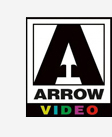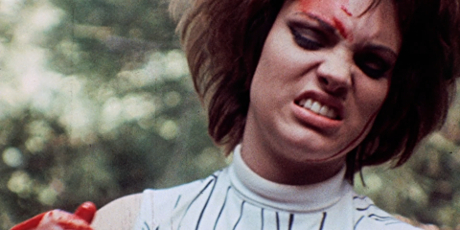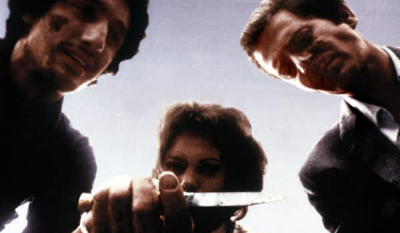The Last House on the Left
Near the top of the list of movies we do not recommend as a date picture, no way no how, Wes Craven’s gut-wrencher presented a real problem for critics. Whose movie exactly is this? The producer wanted a commercially daring pornographic gore shocker. The writer-director envisioned a political scream of rage against America he considered Evil. Is the film an abomination, or an honest reflection of society in chaos?

The Last House on the Left
Blu-ray
Arrow Video USA
1972 / Color / 1:85 widescreen / 84, 92 min. / 3-Disc Limited Edition / Street Date July 3, 2018 / 3-Disc Limited Edition / Available from Arrow Video
Starring: Sandra Cassel, Lucy Grantham, David Hess, Fred J. Lincoln, Jeramie Rain, Marc Sheffler, Gaylord St. James, Cynthia Carr.
Cinematography: Victor Hurwitz
Film Editor: Wes Craven
Special Effects: Troy Roberts
Original Music: David Hess
Produced by Sean S. Cunningham
Written and Directed by Wes Craven
For an unsuspecting audience Wes Craven’s The Last House on the Left is a tough subject, an ordeal, an unjustified assault. For diehard gore-horror fans it’s simply another rite of passage. Its director Wes Craven apparently took it on as a genuine cinematic rage against the America that committed atrocities on other peoples but back home pretended to be pious and good. The movie thus has appeal to both mouth-breathing bloodthirsty gorehounds, and to self-styled intellectual rebels. The main obstruction to my personal endorsement is its foundation in porn film production. The movie is both a legit expression of political rage, and the cheapest form of screen exploitation. That’s the price of Freedom, so let it screen.
In 1972 Last House on the Left was just a shocker heralded by grimy newspaper ads, following in the still-notorious tracks of George Romero’s Night of the Living Dead. I remember seeing the name ‘Wes Craven’ and thinking that it had to be a fake, for sure. Even in partly trimmed versions, the film represented a quantum leap forward in what could be shown on American screens. Few prints survived circulation without being censored by distributors, or by exhibitors right in the theaters where it played. For a standard audience it’s still an indefensible carnival of cruelty, with unendurable pain and suffering meted out to two innocent girls by a quartet of pitiless human monsters. The movie can claim a certain legitimacy, but it’s also a commercial product made by daring filmmakers that took to heart (and stomach) the notion that the only way to get attention in the film biz was to be as shocking as possible.
It all starts as an ordinary day. Virginal but adventurous Mari Collingwood (Sandra Cassel) leaves her country home to attend a rock concert with her more worldly friend Phyllis Stone (Lucy Grantham). They stop off to score some dope on the way, and like lambs to the slaughter, fall into the clutches of Krug Stillo (David Hess) and his informal group of craven criminals: ‘Weasel’ Podowski (Fred J. Lincoln), the aptly-named Sadie (Jeramie Rain) and Junior (Marc Sheffler), a neurotic drug addict. Mari and Phyllis are driven to the woods in the trunk of Krug’s car, where they’re tormented through sick games, and then sadistically raped and murdered. When the killers’ car won’t start, they stop off for help at a local house, posing as harmless straights. But what Krug and Co. don’t know is that they’ve come right back to Mari’s neighborhood, and their friendly hosts just happen to be the parents of their victim.
Most horror fans are aware that the plot of this shocker is borrowed from Ingmar Bergman’s The Virgin Spring, although the producer of Last House, Sean Cunningham, prevaricates by claiming their source was the same Scandinavian folk tale that Bergman used. The notoriety surrounding this film hasn’t gone away, from the ‘It’s Only a Movie’ tagline to the ballyhoo suggestion that the movie had value as a warning lesson for parents to teach their children.
Last House is undeniably frightening. Its first section, before we get to the Collingwood house, is competently filmed. The acting is excellent and extremely believable, especially David Hess and his ferocious partners. Although it began as an ‘adult’ movie made by adult filmmakers, Wes Craven’s aim to make the worst possible horror scenario has a legitimate artistic basis. A growing number of contemporary mainstream films like The Wild Bunch had expressed the boiling violence of the times; I believe Craven when he says his cinematic atrocities were his reaction to the turmoil of Vietnam, Charles Manson, the ’60s assassinations and Richard Nixon’s America in general. In 1971, the country was a pressure cooker that some radicals believed would actually spiral into revolution. Some of the ‘Silent Majority’ were disturbed by the thought of a rising tide of violence.
Charlie Manson laughed at the establishment, predicting that its own children would ‘come at them with knives’ in retribution for society’s hypocrisy. Krug and Co. is that exact nightmare, an alternate family of sex killers and dope addicts, a fusion of sick personalities that encourage the worst in one another. They respect nothing. They have free sex. They sell drugs. Mari and Phyllis’ very innocence triggers Krug’s lust to defile and destroy, to outrage even himself.
Last House differs from previous, relatively tame terror sieges like Lady in a Cage in that it tears up the assumed ‘contract of politeness’ with the audience. Critics often made facile observations about violence in movies, saying that every new cinematic wrinkle in cruelty or sadism further desensitized audiences. But the violence was usually not directly depicted: in Robert Aldrich’s The Dirty Dozen, the German victims are not actually shown being blasted or incinerated. Last House is totally outside this idea. The basic brutality here laughs at unspoken agreements, and shows everything directly.
The torments in Last House are direct and pitiless, and covered with a documentary eye so passive that it all could be real. Nothing is stylized, not even to the extent that the atrocities in something like Salo are ‘aestheticized.’ Craven knew that terror is in the details, and that’s why he adds the disturbing incident where Phyllis is made to urinate on herself. It’s a relatively tame humiliation, but the line has been crossed. Ever have a boss, or a ‘friend’, insist you do something just for the principle of demonstrating who’s in charge? It’s the same principle: “See what I can make you do? See what I can do to you?” The horror shared by all is that both victim and tormentor know the stakes will soon escalate.
Phyllis and Mari are breathing, shivering, pleading girls one minute, and after an extended agony, dead meat. When their mutilated victims are gone, the killers collapse into sullen silence. They are beyond the pale, yet there remains a pitiful humanity in their nervous, self-disgusted ‘regrouping’ after the crime.
Craven’s plan to bring the horror full circle with the borrowed structure of The Virgin Spring is sound, but, unlike the later Tobe Hooper and Sam Raimi gore-fests, his production lacks the basic technical sophistication for the third act at the Collingwood house. It’s all interiors, which require experience to light. The cramped spaces cause the camera coverage to be broken up into more conventional angles, which can’t match the docu veracity of the exteriors. The final reels are distractingly amateurish.
The violence in the house is also less honest than the horror in the woods. The Collingwoods use the best tricks they can come up with, but this is more plotted and hyped — with one of the first manic uses of a chainsaw. There’s an obvious obscene bit where Estelle Collingwood (Cynthia Carr) bites off a piece of Weasel’s anatomy. It’s a cheap bit of obscenity straight from the Herschel Gordon Lewis school of exploitative shock. The pandering instincts of the filmmakers is what makes it cheap.
The self-serving Cunningham again sidesteps when he describes his previous soft-core and borderline hardcore work as being ‘documentary.’ It’s important to remember that Last House on the Left was made by pornographers attempting to diversify. In general, the whole third act is an artistic betrayal of the honest terror in the woods. ‘Just remember,’ the advertising should say of this section, ‘It’s only degrading exploitation.’ Of course, blatant sadism is a frequent commodity in much of today’s horror filmmaking, what with Gore Porn like the Saw franchise.
The ‘Crime and Retribution’ angle doesn’t work too well. The random, senseless slaughter of the two girls is the kind of crime that happens too often to be ignored, and therefore has validity. But when the killers are delivered unto the Collingwoods for a payback slaughter, the show becomes an even uglier vigilante fantasy. The Collingwoods aren’t Max Von Sydow. They don’t pull heirloom swords from the attic and re-forge them as weapons for a ritual slaughter. They’re an average couple that presumably hasn’t had survivalist and terror scenarios running through their heads for years (as many people do now, admittedly). Their response is a horror-comic fantasy entirely different than the raw realism in the woods. The show really stumbles when the Collingwoods retrieve their daughter’s body. They just sit over her a moment, and then it’s back to Killing 101. There’s no pause for them to recover from their emotions. When they go into battle with such cool heads, the believability connection is lost.
True, a consistent finale would definitely not have been as thrilling for the audience. Krug and his fiends might believably escape direct punishment, even if convicted of other crimes. If they were caught, legalities would probably mandate a protracted, agonizing trial, as in The Onion Field. But The Last House on the Left is first and foremost an exploitation film. Viewers sobered by the horror in the woods respond like a mob in cheering the slaughter at the house. I wouldn’t be surprised if Craven and Cunningham originally planned a more naturalistic variation on a Herschel Gordon Lewis film, and their superior cast inspired them to overachieve in the first section of the movie.

Arrow Video USA’s 3-Disc Limited Edition Blu-ray of The Last House on the Left is a return to this genuine horror landmark. The disc notes say that the new transfers were done from 35mm enlargement elements, because the film’s original 16mm long ago went missing. The three cuts included are The Unrated Cut, the R-Rated Cut and a third called the Krug and Company Cut. I was surprised to discover that the long, 92-minute cut is the R-rated version.
Advances in scanning techniques certainly make a difference, and the encoders/colorists have used good sense in optimizing the one good picture element they had. The grain is down and the color up from earlier transfers, but they haven’t tried to disguise the 16mm source. The cameraman has only two credits under this name, but he obviously had a lot of experience — the picture is rather sharp for a 16mm original. The rough & ready filming conditions in cars and in the woods still look good; I think the previous MGM encoding tried for too much contrast.
Arrow doesn’t call this an ultimate edition, but the compilers of extras have done their best to be inclusive with extras. The old MGM items are here, but in some cases improved; the lengthy reel of outtakes have been given an entirely new transfer, for instance. The old, lengthy documentary presents the producers and actors in fairly frank interviews. All comment on the film’s enormous influence. Wes Craven characterizes himself as being stoned half the time during shooting; although he was no kid, in the outtakes he looks like a longhaired art student. In some of the old interview materials Craven betrays ambivalence toward his film and sometimes sounds almost sounds ashamed of it. Cunningham makes curious claims to loftier ambitions: his allusions to this being a spiritual film like Bergman’s are mildly offensive. The fact that Last House gives its heroines an undeveloped lesbian relationship points not to a progressive attitude, but to the exploitative spin of a (presumably) more sexually explicit original concept.
Both producer and director participate in the engaging commentary, telling the story of the making of the film while poking fun at themselves. They come off better here than in the docu — Craven has a wry sense of humor and Cunningham is more open about the primitive level of production he was able to muster. Appropriately, they sober up somewhat around the area of the murder. It’s obvious that Craven, at least, is still somewhat conflicted by his exercise in horror.
The Outtakes section, for those who need to know, includes a lot of fake entrails pulling that will either sicken or amuse. The short bits of film include a great many stage waits and post — “Cut” moments that happily show that the actors are just acting. I have to say though, that it’s still upsetting whenever Lucy Grantham twists her face into agonized mode. It’s a professional cast, even though most of the main players made few movies (at least as listed in the IMDB). David Hess has a continuous list of acting credits, and Fred J. Lincoln became a prolific porn director — the list of titles he’s directed is mind-blowing.
Another old section called Forbidden Footage is not legendary gore cut from the film but a discussion of the roughest scenes already in the movie. It plays like a chapter exiled from the docu. Lucy Grantham seems pleased that her urination scene was authentic. I don’t think the extras show any excised footage but instead offer alternate or extended bits from the outtakes. (A couple of added bits, like a longer view of Junior’s head wound, are in the docu as well).
The volume of newer extras, spread across two discs, is mind-boggling. David Hess plays his guitar at every opportunity, and his tracks seem to dominate the soundtrack CD that comes with the set as a third disc. As ground zero for a lot of gore-film worship, Last House was a frontrunner in the English ‘video nasties’ flap, covered elsewhere. One extra on disc two is video footage from a first-ever public screening in England, in 2000. A full list of extras is below.
Pictures like The Last House on the Left moved horror away from abstract and romantic notions to gut-wrenching literalizations of real terror in the real world. Raw sex and raw violence in films have an instinctive attraction of their own that works outside of dramatic and aesthetic considerations. This ordeal isn’t about suspense, subtlety or cinematic graces. It even has cheap comic relief with bumbling cops and a black chicken farmer to lower the sophistication quotient. The example of the late ’60s porn explosion naturally gave horror directors the notion of transgressing even farther than had Night of the Living Dead, and with The Last House on the Left, the genre took a plunge into X-rated territory.
I’ve heard enough creepy reactions from horror film fans to know that Last House is no longer even considered strong stuff. That’s too bad because I believe that desensitization does have an effect on mental health. I still respect the work of Wes Craven, and much of his later output satisfies me that his goals here were not perversity for its own sake. The show itself remains a genuine horror landmark, one of several that put an end to older, stylized, beautiful horror: we’re not going back again, only forward. I can just see William Friedkin seeing this movie and knowing that the time was ripe for a mainstream horror picture to blow the culture wide open.
Reviewed by Glenn Erickson

The Last House on the Left
3-Disc Limited Edition Blu-ray rates:
Movie: Good, but not recommended for any but fans of gore
Video: Very Good
Sound: Very Good
Supplements (via Arrow): Disc One: New: Isolated score remastered from the original 17.5″ magnetic tracks; audio commentary by podcasters Bill Ackerman and Amanda Reyes; Junior’s Story — interview with actor Marc Sheffler; Blood and Guts — interview with makeup artist Anne Paul; The Road Leads to Terror — featurette revisiting the film’s original shooting locations. Archival: audio commentaries: (1) with Wes Craven and Sean S. Cunningham, (2) with stars David Hess, Marc Sheffler and Fred Lincoln. Introduction by Wes Craven; Still Standing: The Legacy of The Last House on The Left — interview with Wes Craven; Celluloid Crime of the Century — documentary with interviews with Wes Craven, Sean S. Cunningham, actors David Hess, Fred Lincoln, Jeramie Rain, Marc Sheffler and Martin Kove; Scoring Last House on the Left — interview with actor/composer David Hess; It’s Only a Movie: The Making of The Last House on the Left — documentary; Forbidden Footage — the cast and crew on the film’s most controversial sequences; Deleted Scene — Mari Dying at the Lake; Extended Outtakes and Dailies newly transferred in HD; Trailers, TV Spot & Radio Spots; Image Galleries. Disc Two: New: Q&A with Marc Sheffler from a 2017 screening of the film at The American Cinematheque; The Craven Touch — interview featurette with Sean S. Cunningham, composer Charles Bernstein, producer Peter Locke, cinematographer Mark Irwin and actress Amanda Wyss; Early Days and ‘Night of Vengeance’ — filmmaker Roy Frumkes remembers Wes Craven and ‘Last House on the Left;’ Tales That’ll Tear Your Heart Out — excerpts from an unfinished Wes Craven short; Krug Conquers England — archival featurette charting the theatrical tour of the first ever uncut screening of the film in the UK. Disc Three (CD): original motion picture soundtrack, newly remastered. Additional: Limited Edition 60-page book with essay by Stephen Thrower; 6 lobby card reproductions; Double-sided poster.
Deaf and Hearing-impaired Friendly? YES; Subtitles: English (feature only)
Packaging: One Blu-ray in Keep case
Reviewed: June 15, 2018
(5755last)
Visit CineSavant’s Main Column Page
Glenn Erickson answers most reader mail: cinesavant@gmail.com
Text © Copyright 2018 Glenn Erickson








